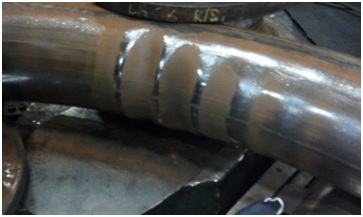Rippling on the surface of a pipe is a somewhat common problem that occurs during bending operations. Learning about the reasons behind the rippling can help avoid this issue.
Ripples are caused by high levels of compressive force on the inside of a pipe or tube with thin wall thickness. Thicker pipe walls can withstand higher compressive forces on the inside of a bend without distorting or wrinkling. With custom rolled pipe, material on the outside of the bend stretches – this causes wall thinning. The material resists this thinning and as a result the outside surface of the bend wants to cave in. This causes the flawed profile shape we know as ovality or distortion.
For precision work, material cannot have ovality or distortion because there may be a need to splice a bent pipe to a straight pipe. If the profiles of these two mating parts are different, there may be an issue fitting them up to each other. This especially comes into play when you have a pressure application and something needs to run through the pipe.
To avoid distortion when bending pipe, it starts with evaluating the material itself. Pipe comes in many sizes with varying wall thicknesses. It is important to keep in mind that the wall thickness can have nominal variations.
Some pipe sizes perform better in minimum wall thicknesses and above. With cold rolling specifically, a large diameter pipe with a thin wall does not bend well and can even be difficult to bend to large radiuses with a slight curvature. This is because the ratio of diameter to wall thickness of the material is too large and translates to an unstable profile shape. Here is a 12” pipe with too-thin of a wall thickness, which caused ripples during the cold rolling process.

Increasing the pipe’s wall to the next schedule can help avoid rippling – or changing the bending method. Part two of this post will discuss how to choose the right tooling and machinery.







